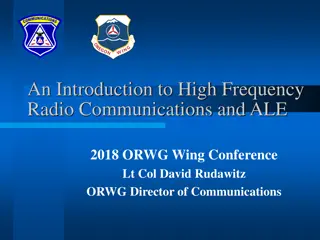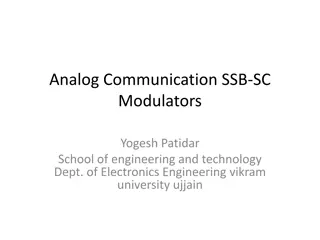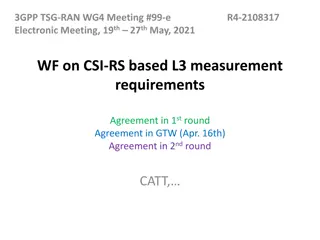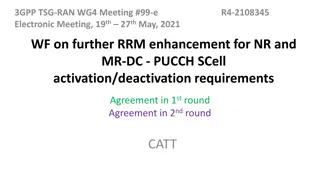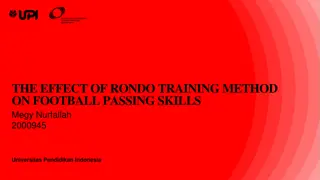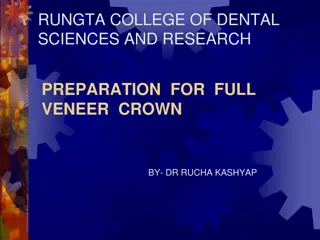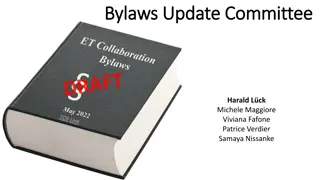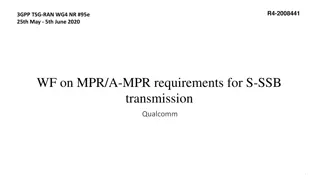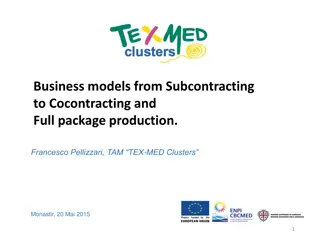
Unveiling the Intricacies of Symmetry Breaking and Quantum Mechanics
Delve into a fascinating array of topics including superconductivity, conservation laws, Wiedemann Effect, Curie's work, Ising model, and more. Explore the realms of degeneracy, ground state symmetry, NG modes, and BCS mechanism, unveiling the complexities of quantum physics and symmetry operations.
Download Presentation

Please find below an Image/Link to download the presentation.
The content on the website is provided AS IS for your information and personal use only. It may not be sold, licensed, or shared on other websites without obtaining consent from the author. If you encounter any issues during the download, it is possible that the publisher has removed the file from their server.
You are allowed to download the files provided on this website for personal or commercial use, subject to the condition that they are used lawfully. All files are the property of their respective owners.
The content on the website is provided AS IS for your information and personal use only. It may not be sold, licensed, or shared on other websites without obtaining consent from the author.
E N D
Presentation Transcript
SSB BCS Hierarchical SSB Color superconductivity SSB anomalies Lie SSB Nielsen anomaly Lorentz anomaly Newton anomaly
(conservation laws) Noether (1918) selection rules) Pierre Curie (1859-1906)
Wiedemann Effect (G. H. Wiedemann 1822-1899) B, J t
P. Curie =Senv =Seff Senv = Seff Rz: Rx, Ry: (T: B -> B B -> -B J -> J t -> -t B -> B J -> -J J -> -J t -> -t t -> -t) Jacobi, Poincare)
SSB(: SL> Senv= Seff P. Weiss E. Ising W. Heisenberg 1907 1925 1928 Heisenberg 1959 Hint= g J5 J5
SSB Dynamical Degeneracy of the ground state symmetry Continuous symmetry continuous degeneracy Degrees of freedom N (thermodynamic limit) Superselection rule NG (Nambu-Goldstone) modes, (restoration of lost symmetry) No. of NG modes = No. of broken symmetry operations (with exceptions) N = G/H NG NG 1/ 1/ Spin wave phonon
Finite systems NG modes -> low lying states ( rotational band ) polyatomic molecules (Jahn-Teller 1937) `P-P, N-N pairing in Nuclei strong coupling meson theory / Skyrme model (Wentzel 1940 / Skyrme 1961)
BCS mechanism Fermion Cooper pairing -> mass gap formation original dynamics (high energy) scale SSB (low energy) scale NG ( ) and Higgs ( ) modes Mass relations (quasi-supersymmetry) m : mf: m ~ 0 : 1 : 2 (weak coupling) sum rule: e.g. m( 12)+ m( 2)2= 4m(f)2 Effective theories Ginzburg-Landau-Gell-Mann-Levy model Nonlinear model
Majorana mass term ( k -k + k -k )
Superselection rule: = ( i i+ i iai i a - -i i)|0F F>, >, i i2 2 + + ( F F, ,, , ) = i i2 Bogoliubov-Valatin quasifermion ( - -i i massless (NG) + massive (Higgs) bosons NG i i2 2=1 1 2 - -> > 0 V = i i i i + i i B B - -V i i NG 1/
Examples Superconductivity (SC) s wave Superfluid 3He p wave j = 0 (B phase), j = 2 (A phase) P-P and N-N pairing in nuclei s wave Interacting boson model (IBM) ? QCD-hadron chiral dynamics Weinberg-Salam electroweak theory Flavor dymanics (Higgs mechanism) ? Color SC ? d wave (high Tc)
BCS Hamiltonian Hint= - (G2/M )( Hint = - G( + Majorana mass (gap) term ( k -k + + k -k ) ) Gap equation 1 = (G2/M )F( , ), FBCS~ C 2 ln( / ), Yukawa coupling 1/f ~ F/ m 2~ C ln( /m) H = -G( + ) + M ) ) ) + M
Effective GL-GL () model f f g g = = g4 4 4
Effective model L= Lf + + g ( k -k + k -k ) ) - - g2 2( v2)2, gv = Quasi-supersymmetry H = {Q, Q } (Q2 0)
3He (l =1, = 1) -> j = 0, 1, 2: B phase, j = 0 A phase j = 2 l , l x , li k 1 1, 2 2 IBM J = 3/2 shell (e.g. Pt), -> 6 bosons -> a ( - v v2 2 ) )2 u(4) o(6) x u(1) i , , b ( m m n n- - i , j = 0, 2 , j = 0, 2 m n n 2 - - b ( m ) )2 2
Name v =<>(ev) (ev) g ________________________________ supercondictor ~10 10 ev ~ 0.1 He ~103 QCD-chiral dynamics 100Mev 1Gev 10 nuclear pairing ~ 100Mev 1Mev ~ 10 standard model 250Gev 174Gev(t) 0.68 10 6 ~ 0.05
Hierarchical SSB chains ( Dimopoulos, Raby and Susskind in GUT hierarchies, 1980) 1) phonon chain: atomic interaction SSB1 crystal formation --- phonons --- e-e attraction SSB2 superconductivity, energy gap and collective states 2) hadronic chain: QCD --- qq and qqq attraction SSB1 massive q's, nucleons and ( , ) --- N-N attraction SSB2 nuclear formation and N-N pairing, IBM bosons as a quasi- - 3) Color SC chain: QCD --- qq attraction --- quark medium SSB1 Majorana mass ---- quark mass chemical potential SSB2 meson condensation
Color superconductivity in high density quark matter B. Barrois (1977); S. Frautchi (1978) D. Bailin and A. Love(1981) M. Alford, K. Rajagopal, and F. Wilczek (1998) EF= ----------------- Majorana mass term qq (vector and/or scalar) 0_______________ quark mass term q q Chiral SSB -> NG bosons = mesons Effect of (current) quark masses -> -> 2nd SSB (meson condensation) -> new NG bosons
Nielsen anomaly: No. of zero modes (NG bosons) N_z N = No. of generators in the coset G/H, = ck , N = i i H. B. Nielsen and S. Chadha (1976) SSB by a chemical potential H = H0 N, i / t = (H0 N) L: / t -> / t i V. A. Miransky and I. A. Shovkovy (2002)
H0- Q Q
[Qi, Qj] = iQ0, [Zi, Zj] = iC Q0 = C A U(2) model : = ( (1), (2)), (K meson or Higgs ) L = ( + i ) ( - i ) - - m - ( ) , H = + + m - Q + ( ) , = + i ) , = ( - i ) , Q = - i( - ) = (x + iy)/ 2, = (px + ipy)/ 2, = (u + iw)/ 2, = (pu + ipw)/ 2.
H = 1/2[(px+ y) + (py- x) + (pu+ w) + (pw- u) ] + (m - )(x + y + u + w )] + (x + y + u + w ) /4, px+ y = 0, py- x = 0, pu+ w = 0, pw- u = 0, m x- py= m y+ px= m u pu = m w+ p_u = - (x + y + u + w ) - R , or R = - m (>0), x -> v +x, py-> v + py, H = (1/2)[(px+ y) + (py- x) + (pu + w) + (pw- u) + k (x + y + u + w )]( - m )x - /(4 ) + nonlinear terms = (px + py + pu + pw )/2 + ( + k )(x + y + u + w )/2 + ( - m )x - py- ypx+ upw- wpu) - /(4 ) +
Qi Qi= Qi + Zi , Z = Z = v(py+ x)+ v , Z = v(pw+ u), Z = v(pu- w), [Z , Z ] = 2iv
Assumed: Hcoll= A(p,q) + kB(p,q), [A,B] 0 (unless A=0). (The kinetic energy causes excitations.) 1) A depends on both p and q: A = A(p,q), 2) A = A(p) (or equivalently A = A(q)), 3) A = 0. Case 1) Higgs mode. At k = 0, H takes the form of a harmonic oscillator, so const.+ k2. Case 2) NG mode A(p) (or A(q)) and B(p,q) together form a harmonic oscillator, so k. (Holds for Z from (1).) Case 3) Anomalous zero mode. Applies to Z and Z from (2).They would appear as conjugates and massive like Case 1, which is a contradiction for zero modes. Hence A = 0, B = B(p,q), and k trivially.
Examples: Ferromagnetism and antiferromagnetism Si= i/2, i = 1..3, Oi= even i/2 - odd i/2, O = C, S =0. [Si,Sj] = [Oi,Oj] = i ijkSk, [Si,Oj] = i ijkOk S k2, O k
Breaking of Lorentz symmetry: D. Collady and V. A. Kostelecky (1998) ( p m + gv z) = 0 The dispersion law (p - m )(p - m ) = 4g m v , p = p + m + g v 2gv(pz + m )1/2 = px + py + ((m + kz )1/2 gv) z = pz gv,
Dispersion law for a quasiparticle 25 20 15 10 5 -5 0 x -4 -2 2 y 4 5
Collective modes: broken gauge field Lcol = L V V , L = Ag k + Bk k + Cg k + Dg3 g3 k + Eg3 g3 k + F(g3 k k + g3 k k ) + iG 3 k - M g - M g3 g3 Induced Chern-Simons term: iG 3 k (S.M.Carrol, G.B.Fried, and R.Jackiw (90), rotation of photon polarization) Induced Schwinger term in current algebra: [j (0),ji(x)] = C 30ik k (x), C gv
Newtonian anomaly: classical behavior of quasiparticles E. g. Bogoliubov-Valatin fermion Landau phonon-roton Question: Simplified Hamiltonian: H = ap - bp + V(x) dx/dt = v = 4ap - 2bp dp/dt = - dV/dx L = pv(p) H
= ap - bp, a, b>0 14 12 EF 10 8 6 4 2 p -4 -2 0 2 4 p V<0 V>0 V<0 V>0 pF - pF
v = d/dp = 4ap3- 2bp 10 8 6 4 2 0 -4 -2 2 4 p -2 -4 -6 -8 -10
= (p)+(-p) gravity p space
Plot of x(t), H = ap - bp + gx, x 1 0.8 0.6 0.4 0.2 t -4 -2 0 p 2 4
The Unruh problem (G. W. Unruh 1976, S. Hawking 1974) = V = (1 + gz/c ), or H = H(1+ z) This form of the Hamiltonian is for an observer moving with uniform acceleration in the z direction. The term zH may be regarded as a "chemical potential" for Lorentz boost i (z t+ t z), (t set to 0). In quantum field theory it leads to the wave equation in the Unruh coordinates, leading to a thermal medium of T = 2 g . The present anomay would also apply to a co- accelerating medium and observer.
Unruh coordinates t = sinh , x = cosh , x2 t2= 2
t =sinh(a), x =cosh(a) , (a= ) dt/d = ax, dx/d = at ds =-d + a d exp( iEt + ikx + i )d = exp[ imx sinh( = exp[ imx sinh + i ( ]d = 2exp( ( /2 - - i i ) K ) + i ]d i (mx ) (K = K- ) a = a exp( /2) + a exp(- /2)
Universality of SSB 2. NG boson anomaly 3. SSB of Lorentz invariance?? (neutrino sector??) 4.





